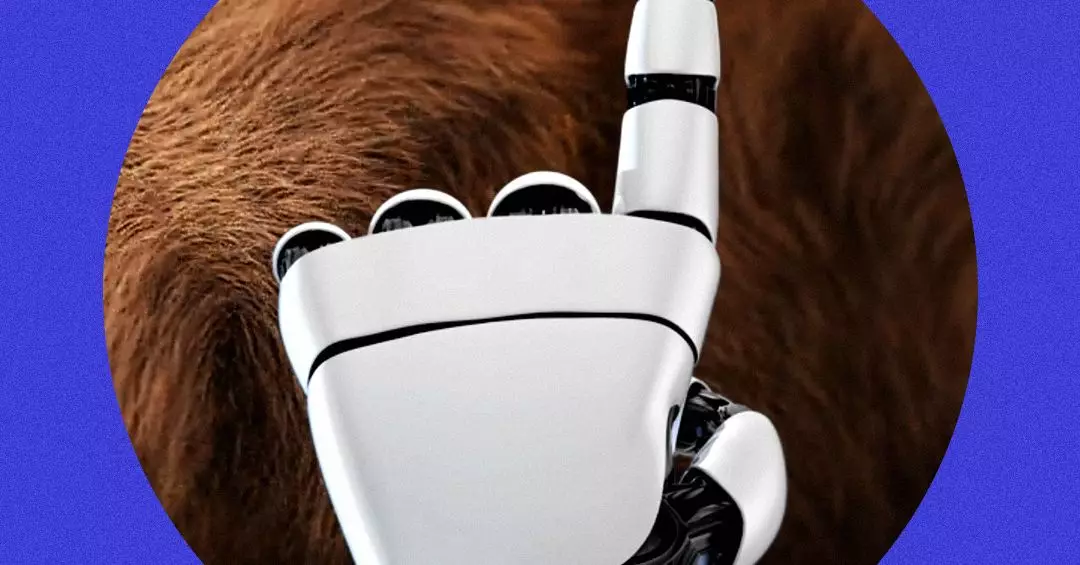Imagine a world where machines interact with their environment as deftly as humans do—where a robot can maneuver through a maze of objects, accurately selecting the right item with just the right touch. Amazon’s latest innovation, the Vulcan robot, heralds the onset of such a future, demonstrating a significant advancement towards integrating tactile capabilities into robotic systems. As consumers increasingly expect swift delivery timelines, the necessity for more sophisticated automation in fulfillment centers could not be more pressing.
Vulcan is no mere addition to Amazon’s warehouse arsenal; it represents a paradigm shift in robotic interaction dynamics. This specialized robot is engineered to navigate complex shelving systems, leveraging a unique blend of hardware and machine learning to identify and retrieve products with unprecedented precision. By enhancing robotic touch, Amazon seeks to lessen the physical burden on human employees while maintaining–or even augmenting–efficiency.
The Mechanics Behind Vulcan’s Touch
At the heart of Vulcan’s design is a traditional robotic arm, somewhat transformed by the inclusion of an innovative spatula-like appendage. This design facilitates the robot’s unique ability to poke, prod, and interact with items on shelves effectively. Coupled with a sophisticated suction mechanism, Vulcan can both sift through goods and extract products seamlessly. Notably, the sensors embedded in the robot’s joints furnish critical information about the size, shape, and contour of objects, acting as digital fingertips that inform its movements.
Aaron Parness, Amazon’s director of robotics AI, articulates the importance of tactile feedback in warehouse operations. The need for direct contact is paramount; without it, the robot would struggle to fulfill its operational role. Parness emphasizes that the breakthrough lies in the “special sauce”—the software algorithms that interpret sensory signals and integrate them into a coherent action plan. This nuanced understanding places Vulcan at the forefront of robotic innovation, melding physical capability with advanced AI.
Challenges and Triumphs in Robotics
While Vulcan is on the cutting edge, the challenges in robotic touch sensing remain formidable. Roboticists like Ken Goldberg underscore the intricate nature of human touch, which encompasses a vast dynamic range of sensitivity and responsiveness. The aspiration to replicate such complexity in robots is ambitious; as Goldberg notes, human-equivalent tactile sensors are at least a decade away. Yet, progress is evident. Over the past few years, collaborative efforts across research groups have yielded promising advancements in joint and surface sensing.
Though Vulcan is sophisticated, it does not render human workers obsolete. Instead, its introduction aims to alleviate some of the more labor-intensive tasks, allowing employees to focus on higher-value activities. It may even foster improved efficiency within fulfillment centers, blending human capabilities with robotic strength in a synergistic work environment.
The Future of Fulfillment and Automation
As technology evolves, the question of automation’s limits becomes increasingly pertinent. While Parness suggests that complete automation is not within Amazon’s scope, his vision for a collaborative system—where humans and robots coexist—paints an optimistic picture of the future. By managing the more strenuous aspects of order fulfillment, Vulcan aims to enhance workplace ergonomics while ensuring that humans retain their indispensable touch.
The rollout of Vulcan in fulfillment centers in Hamburg and Spokane signifies a strategic acceleration in Amazon’s automation agenda. With the backdrop of rising e-commerce demands, such innovations not only enhance operational capacity but also set a new standard for industry practices. Robots capable of handling complex warehouse tasks could redefine logistics, setting new benchmarks for speed and accuracy.
Embracing a New Era
The arrival of Vulcan signifies more than just another robotic assistant; it encapsulates a shift towards a future where robots are not characterized by brute force but by finesse and dexterity. Amazon’s continual investment in robotics and AI not only showcases technological prowess but also highlights the company’s commitment to reimagining the workforce landscape. As we witness the unfolding of this new era, the interplay between human and robotic capabilities will be fascinating—one that holds the potential for remarkable changes in how we process and fulfill our most basic consumer needs.


Leave a Reply